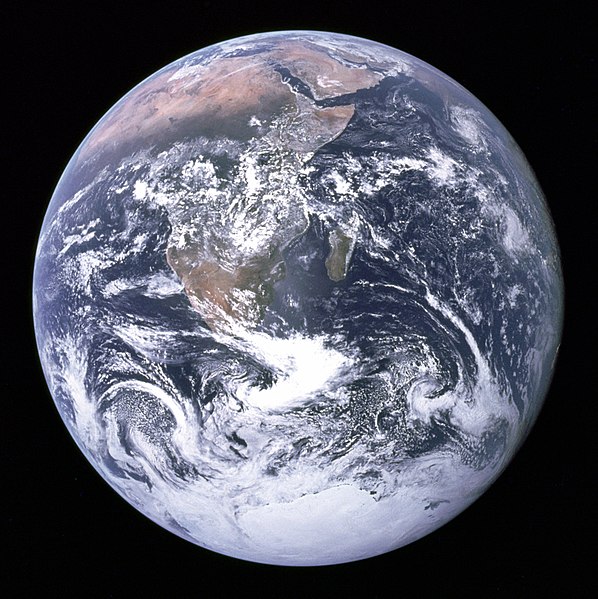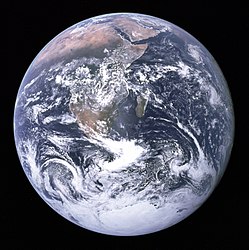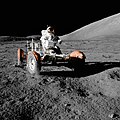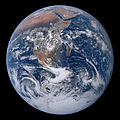File:The Earth seen from Apollo 17.jpg
Jump to navigation
Jump to search


Size of this preview: 599 × 599 pixels. Other resolutions: 240 × 240 pixels | 480 × 480 pixels | 600 × 600 pixels | 767 × 768 pixels | 1,023 × 1,024 pixels | 3,000 × 3,002 pixels.
Original file (3,000 × 3,002 pixels, file size: 6.21 MB, MIME type: image/jpeg)
| This is a featured picture, which means that members of the community have identified it as one of the finest images on the English Wikipedia, adding significantly to its accompanying article. If you have a different image of similar quality, be sure to upload it using the proper free license tag, add it to a relevant article, and nominate it. |
| This image was selected as picture of the day on the English Wikipedia for November 12, 2004, February 28, 2005, and January 4, 2006. |
File history
Click on a date/time to view the file as it appeared at that time.
| Date/Time | Thumbnail | Dimensions | User | Comment | |
|---|---|---|---|---|---|
| current | 21:19, 28 March 2017 |  | 3,000 × 3,002 (6.21 MB) | Natuur12 | Reverted to version as of 16:11, 24 March 2017 (UTC) |
| 16:11, 24 March 2017 |  | 3,000 × 3,002 (6.21 MB) | Thibaut120094 | Reverted to version as of 16:09, 24 March 2017 (UTC) | |
| 07:45, 18 December 2012 |  | 3,000 × 3,002 (6.21 MB) | Huntster | Reverted to version as of 02:25, 31 July 2005; please do not overwrite featured pictures with modified versions. | |
| 14:11, 17 December 2012 |  | 2,400 × 2,400 (2.98 MB) | Adzo.1 | Image refaite directement à partir du fichier source NASA AS17-148-22727. | |
| 07:42, 17 October 2010 |  | 3,000 × 3,002 (6.21 MB) | Huntster | Reverted to version as of 02:25, 31 July 2005; new image is (in my opinion) technically inferior to the July 2005 image, and is not the featured picture that was voted upon. Upload new image to another filename if desired. | |
| 06:16, 17 October 2010 |  | 3,720 × 3,796 (10.46 MB) | Jeff G. | *Higher-quality and higher-resolution image: apollo17_earth.tiff as contained by ftp://nssdcftp.gsfc.nasa.gov/photo_gallery/hi-res/planetary/earth/apollo17_earth.tiff.gz and converted to JPEG with 100% quality using [[w:Paint.NET|Paint.NET v3.5 | |
| 02:25, 31 July 2005 |  | 3,000 × 3,002 (6.21 MB) | Tom | larger image | |
| 22:41, 29 December 2004 |  | 1,860 × 1,898 (762 KB) | Ed g2s | {{PD-USGov-NASA}} |
File usage
More than 100 pages use this file. The following list shows the first 100 pages that use this file only. A full list is available.
- 20th century
- Age of the Earth
- Apollo 17
- Apollo program
- Biosphere
- Coriolis force
- Earth
- Ecology
- Ecoregion
- Environmental economics
- Environmental engineering
- Environmental geology
- Environmental law
- Environmental science
- Geodesy
- Hydrology
- List of international environmental agreements
- Nature
- Oceanography
- Poaching
- Pollution
- Space exploration
- Sustainable development
- Water
- World
- World peace
- Talk:Acid rain
- Talk:Air pollution
- Talk:Al Gore
- Talk:Albedo
- Talk:Arsenic
- Talk:Attribution of recent climate change
- Talk:Bhopal disaster
- Talk:Biodiversity
- Talk:Biome
- Talk:Biosafety
- Talk:Biosecurity
- Talk:Biotechnology
- Talk:Bjørn Lomborg
- Talk:Buckminster Fuller
- Talk:Charles Darwin
- Talk:Compost
- Talk:Conservation movement
- Talk:Convention on Biological Diversity
- Talk:DDT
- Talk:Deforestation
- Talk:Ecology movement
- Talk:Environment
- Talk:Environmental Modification Convention
- Talk:Environmental economics
- Talk:Environmental movement
- Talk:Environmental movement in the United States
- Talk:Environmental organization
- Talk:Fuel cell
- Talk:Fusion power
- Talk:Genetically modified organism
- Talk:Geography of Myanmar
- Talk:Global warming controversy
- Talk:Global warming potential
- Talk:Greenhouse effect
- Talk:Greenpeace
- Talk:Human overpopulation
- Talk:Human population planning
- Talk:Ice age
- Talk:Intergovernmental Panel on Climate Change
- Talk:Invasive species
- Talk:Joseph Stiglitz
- Talk:Judi Bari
- Talk:Kyoto Protocol
- Talk:Montreal Protocol
- Talk:National park
- Talk:Natural capital
- Talk:Nature
- Talk:Nuclear weapon
- Talk:Nuclear winter
- Talk:Ozone depletion
- Talk:Passive solar building design
- Talk:Petra Kelly
- Talk:Pollutant
- Talk:Population explosion
- Talk:Protected area
- Talk:Ptolemy
- Talk:Radical environmentalism
- Talk:Renewable energy
- Talk:Republican Party (United States)
- Talk:Risk
- Talk:Science & Environmental Policy Project
- Talk:Snowball Earth
- Talk:Sustainability
- Talk:Sustainable development
- Talk:Sylvia Sayer
- Talk:Tragedy of the commons
- Talk:United Nations Convention on the Law of the Sea
- Talk:United Nations Framework Convention on Climate Change
- Talk:United States Environmental Protection Agency
- Talk:Worldwatch Institute
- User:Berek
- User:Hajhouse
- User:JohnOwens
- User:Kragen
Global file usage
The following other wikis use this file:
- Usage on ab.wikipedia.org
- Usage on af.wikipedia.org
- Water
- Aardverwarming
- Gebruiker:Anrie/Spogbeelde
- Wikipedia:Voorbladartikels 2009
- Wikipedia:Voorbladbeeld week 2 2009
- Wikipedia:Beeld van die week/2009
- Wikipedia:Voorbladartikel week 50 2009
- Werklikheid
- Wikipedia:Voorbladartikels 2012
- Wikipedia:Voorbladartikel week 23 2012
- Gaia-hipotese
- Seldsame Aarde-hipotese
- Ouderdom van die Aarde
- Wikipedia:Voorbladartikels 2017
- Wikipedia:Voorbladartikel week 18 2017
- Wikipedia:Voorbladartikels 2018
- Wikipedia:Voorbladartikel week 8 2018
- Ruimteverkenning
- Usage on als.wikipedia.org
- Usage on ang.wikipedia.org
- Usage on ang.wikibooks.org
- Usage on an.wikipedia.org
- Usage on ar.wikipedia.org
- ماء
- العالم
- كوكب
- الأرض
- علوم الأرض
- مستخدم:ابو منيرة
- بوابة:علم الفلك/مقالة مختارة
- ويكيبيديا:صناديق المستخدم/حوسبة
- مستخدم:Hope(N Forever)
- مستخدم:يوسف الختالي
- طبيعة
- مستخدم:Reham Darwish
- مستخدم:Msmtawansy
- مستخدم:DANGER MAN
- مستخدم:ستبدي لك الأيام
- مستخدم:Flash.pro
- مستخدم:مانع
- مستخدم:Ahmed Sabri
- مستخدم:Albarood
- مستخدم:Realman208~arwiki
- مستخدم:Rassawi
View more global usage of this file.
















